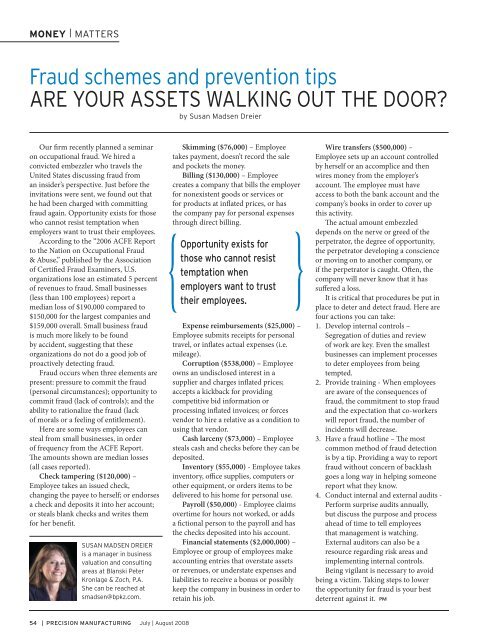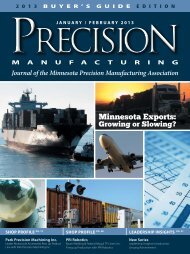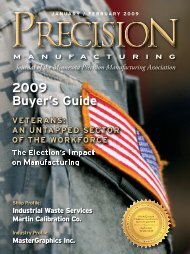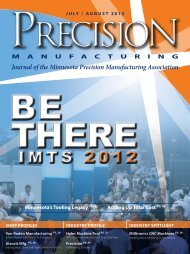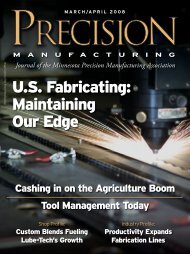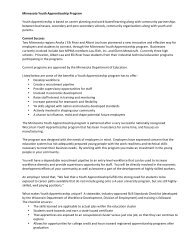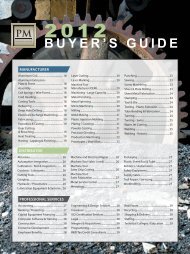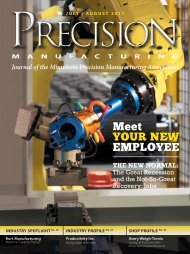July / August - Minnesota Precision Manufacturing Association
July / August - Minnesota Precision Manufacturing Association
July / August - Minnesota Precision Manufacturing Association
Create successful ePaper yourself
Turn your PDF publications into a flip-book with our unique Google optimized e-Paper software.
Our firm recently planned a seminar<br />
on occupational fraud. We hired a<br />
convicted embezzler who travels the<br />
United States discussing fraud from<br />
an insider’s perspective. Just before the<br />
invitations were sent, we found out that<br />
he had been charged with committing<br />
fraud again. Opportunity exists for those<br />
who cannot resist temptation when<br />
employers want to trust their employees.<br />
According to the “2006 ACFE Report<br />
to the Nation on Occupational Fraud<br />
& Abuse,” published by the <strong>Association</strong><br />
of Certified Fraud Examiners, U.S.<br />
organizations lose an estimated 5 percent<br />
of revenues to fraud. Small businesses<br />
(less than 100 employees) report a<br />
median loss of $190,000 compared to<br />
$150,000 for the largest companies and<br />
$159,000 overall. Small business fraud<br />
is much more likely to be found<br />
by accident, suggesting that these<br />
organizations do not do a good job of<br />
proactively detecting fraud.<br />
Fraud occurs when three elements are<br />
present: pressure to commit the fraud<br />
(personal circumstances); opportunity to<br />
commit fraud (lack of controls); and the<br />
ability to rationalize the fraud (lack<br />
of morals or a feeling of entitlement).<br />
Here are some ways employees can<br />
steal from small businesses, in order<br />
of frequency from the ACFE Report.<br />
The amounts shown are median losses<br />
(all cases reported).<br />
Check tampering ($120,000) –<br />
Employee takes an issued check,<br />
changing the payee to herself; or endorses<br />
a check and deposits it into her account;<br />
or steals blank checks and writes them<br />
for her benefit.<br />
<br />
<br />
<br />
<br />
<br />
<br />
<br />
Skimming ($76,000) – Employee<br />
takes payment, doesn’t record the sale<br />
and pockets the money.<br />
Billing ($130,000) – Employee<br />
creates a company that bills the employer<br />
for nonexistent goods or services or<br />
for products at inflated prices, or has<br />
the company pay for personal expenses<br />
through direct billing.<br />
{ }<br />
<br />
<br />
<br />
<br />
<br />
Expense reimbursements ($25,000) –<br />
Employee submits receipts for personal<br />
travel, or inflates actual expenses (i.e.<br />
mileage).<br />
Corruption ($538,000) – Employee<br />
owns an undisclosed interest in a<br />
supplier and charges inflated prices;<br />
accepts a kickback for providing<br />
competitive bid information or<br />
processing inflated invoices; or forces<br />
vendor to hire a relative as a condition to<br />
using that vendor.<br />
Cash larceny ($73,000) – Employee<br />
steals cash and checks before they can be<br />
deposited.<br />
Inventory ($55,000) - Employee takes<br />
inventory, office supplies, computers or<br />
other equipment, or orders items to be<br />
delivered to his home for personal use.<br />
Payroll ($50,000) - Employee claims<br />
overtime for hours not worked, or adds<br />
a fictional person to the payroll and has<br />
the checks deposited into his account.<br />
Financial statements ($2,000,000) –<br />
Employee or group of employees make<br />
accounting entries that overstate assets<br />
or revenues, or understate expenses and<br />
liabilities to receive a bonus or possibly<br />
keep the company in business in order to<br />
retain his job.<br />
Wire transfers ($500,000) –<br />
Employee sets up an account controlled<br />
by herself or an accomplice and then<br />
wires money from the employer’s<br />
account. The employee must have<br />
access to both the bank account and the<br />
company’s books in order to cover up<br />
this activity.<br />
The actual amount embezzled<br />
depends on the nerve or greed of the<br />
perpetrator, the degree of opportunity,<br />
the perpetrator developing a conscience<br />
or moving on to another company, or<br />
if the perpetrator is caught. Often, the<br />
company will never know that it has<br />
suffered a loss.<br />
It is critical that procedures be put in<br />
place to deter and detect fraud. Here are<br />
four actions you can take:<br />
1. Develop internal controls –<br />
Segregation of duties and review<br />
of work are key. Even the smallest<br />
businesses can implement processes<br />
to deter employees from being<br />
tempted.<br />
2. Provide training - When employees<br />
are aware of the consequences of<br />
fraud, the commitment to stop fraud<br />
and the expectation that co-workers<br />
will report fraud, the number of<br />
incidents will decrease.<br />
3. Have a fraud hotline – The most<br />
common method of fraud detection<br />
is by a tip. Providing a way to report<br />
fraud without concern of backlash<br />
goes a long way in helping someone<br />
report what they know.<br />
4. Conduct internal and external audits -<br />
Perform surprise audits annually,<br />
but discuss the purpose and process<br />
ahead of time to tell employees<br />
that management is watching.<br />
External auditors can also be a<br />
resource regarding risk areas and<br />
implementing internal controls.<br />
Being vigilant is necessary to avoid<br />
being a victim. Taking steps to lower<br />
the opportunity for fraud is your best<br />
deterrent against it. PM


